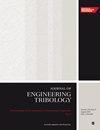Structural selection of liquid hydrogen lubricated herringbone spiral-grooved thrust bearing considering viscous dissipative heat
IF 1.8
3区 工程技术
Q3 ENGINEERING, MECHANICAL
Proceedings of the Institution of Mechanical Engineers, Part J: Journal of Engineering Tribology
Pub Date : 2023-08-13
DOI:10.1177/13506501231194201
引用次数: 0
Abstract
Spiral-grooved thrust bearing (SGTB) is one of the important kinds of supporting component in high-speed rotating devices. The high shearing rate of SGTB can produce a large amount of viscous dissipative heat, which causes a temperature rise. Dynamic pressure effect induces pressure variation in the herringbone SGTB (HSGTB). When liquid hydrogen (LH2) is used as a lubricant, cavitation caused by lower pressure and higher temperature can result in lubrication failure. Especially, the cavitation of LH2 is more prone to occur because of its small temperature difference between the triple point and critical point, and the smaller supercooling degree. The influence of thermal properties on the phase transition process of LH2 is more significant. In this paper, the thermal and mechanical performance of three different structures of LH2 lubricated SGTB is compared by considering viscous dissipative heat. Herringbone SGTB is proposed for better performance and feasibility of its application in LH2 lubrication. The static performances of HSGTB such as load capacity, friction torque, cavitation rate, average temperature, and heat flux have been evaluated numerically by introducing the cryogenic cavitation model. The orthogonal sampling method and range analysis are used to optimize the HSGTB structure. Compared with the original HSGTB, cavitation rate and temperature rise are significantly suppressed in the optimized HSGTB. In addition, the load capacity is also improved effectively at high rotational speed, which is expected to be applied to high-speed centrifugal pumps.考虑粘性耗散热的液氢润滑人字形螺旋槽推力轴承结构选择
螺旋槽推力轴承(SGTB)是高速旋转装置中重要的支承部件之一。SGTB的高剪切速率会产生大量的粘性耗散热,导致温度升高。动压效应引起了人字形sgt内压力的变化。当使用液氢(LH2)作为润滑剂时,低压和高温引起的空化会导致润滑失效。特别是LH2的三相点与临界点温差小,过冷度小,更容易发生空化。热性能对LH2相变过程的影响更为显著。本文在考虑粘性耗散热的情况下,比较了LH2润滑下三种不同结构的SGTB的热性能和力学性能。由于其在LH2润滑中具有更好的性能和应用的可行性,提出了人字形SGTB。通过引入低温空化模型,对HSGTB的承载能力、摩擦力矩、空化率、平均温度和热流密度等静态性能进行了数值计算。采用正交抽样法和极差分析法对HSGTB结构进行了优化。与原HSGTB相比,优化后的HSGTB显著抑制了空化速率和温升。此外,在高转速下也有效提高了负载能力,有望应用于高速离心泵。
本文章由计算机程序翻译,如有差异,请以英文原文为准。
求助全文
约1分钟内获得全文
求助全文
来源期刊

CiteScore
4.20
自引率
5.00%
发文量
110
审稿时长
6.1 months
期刊介绍:
The Journal of Engineering Tribology publishes high-quality, peer-reviewed papers from academia and industry worldwide on the engineering science associated with tribology and its applications.
"I am proud to say that I have been part of the tribology research community for almost 20 years. That community has always seemed to me to be highly active, progressive, and closely knit. The conferences are well attended and are characterised by a warmth and friendliness that transcends national boundaries. I see Part J as being an important part of that community, giving us an outlet to publish and promote our scholarly activities. I very much look forward to my term of office as editor of your Journal. I hope you will continue to submit papers, help out with reviewing, and most importantly to read and talk about the work you will find there." Professor Rob Dwyer-Joyce, Sheffield University, UK
This journal is a member of the Committee on Publication Ethics (COPE).
 求助内容:
求助内容: 应助结果提醒方式:
应助结果提醒方式:


